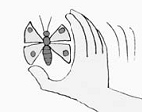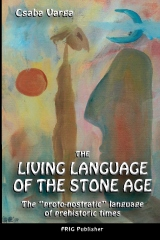|
At
the dawn of humanity, everything was named by its spectacle
Every word-root was the name of a spectacle
Two
words with identical pictures as described by their word-roots, are
dialectical variants of one and the same root.
Most word-roots have been used with diverse pronunciations at
different areas of the same language territory. Those variations
multiplied further by using different languages like (Hu) KöR (circle),
CHURCH or (Ger) KIRCHE. The meaning of them can vary as well.
Examples: the root of the words Kirche, church,
circular, kör <kœr> (circle), kert (garden), keret
(frame), Slav gorod or after metathesis grad and
köröz <kœrœz> (cruising) means a circular built or
encircled, enclosed territory and a circular, not strait movement. (In
the case of church, the archaic places of worship were round,
as Stonehenge and many early Christian churches.) The basic idea of
all is a kör <kœr> (circle) - more accurately - the
imaginary picture of a circle, being kerek (round)
– not strait.
You
rather have to see a word-root’s picture to understand it.
This kind of word-building principle is an inheritance of our early
common ancestors
KÉP = picture
Every
one of our words articulates a KÉP (picture), therefore KÉP has to
have a “picture” as well. Let see what the word KÉP (picture) really
means in Hungarian.
The words KAPó (catcher, receiver) is not just “related” to KOPó (hound,
detective), it is the same word. Both, the hound and the detective
are trained to el|KAP (catch) something. They KEPesnek, KAPosnak <kaposhnak>,
KAPdosnak <kapdoshnak>, KEPesztenek <kεpεstεnεk> (are greedy) (after)
for something. To understand the identity of these words we have to
see their common picture. The KOP|ó is a dog trained to el|KAP (to
catch). KAPzsi <kapži> (greedy) is derived from KAPosó. The change [zs>cs]
or [osó>csó] happened often in Hungarian:
/Lépeső <lepεshoe> became lépcső <lepchoe> (stairs)
Hágosó <haagoshoo>
became hágcsó <haagchoo> (rope-ladder) //
Thus, KAPzsi people are “KAPosó”, KAPdosó, are greedy after
pecuniary matters, sex, or just after butterflies.
The KAPosó person KAPos >>KAPdos and the target of the
KAPosás <kaposhaash> (greediness), a thing
or a person being called
KAPós <kapoosh> (much in request). The
person, who
KAPisgál <kapishgaal>, (begins to grasp it).
You may
KAPdos (snap up) to a slippery soap in the
bathtub. Everybody having seen the many outstretched hands onto a
KAPós (wanted) star on the stage should be
able to understand the meaning of
KAPosni, KAPdosni, the desire to catch.
After this introduction we just can say that KÉP (picture), a
front-vowel variation of KAP, KOP is the most beautiful
philosophical expression of this word-root.
KÉP
is a spectacle we could catch, the caught reality. We may draw,
paint or use a camera, we elKAP (catch) a second of the
ever-changing world like the lepidopterist the butterfly.
Now,
it is possible to understand the extensions of KÉP:
The person who is KÉPes <kepεsh> does not have a KÉP (picture), but
he or she is able to perform, is CAPable of something.
KÉPesség <kepεssheg> (ability) means being
able to KAP, KAPos (to catch).
The KÉPzés (instruction, teaching) (KÉPezés – KAPozás) in reality is
a teaching, the instruction to become a good catcher.
KÉPtelen (impossible) means that we can’t
catch a KÉP (picture) of it.
KAPisgál <kapishgal> = thinking =
észre-vevés <esrεvεvesh> taking to brain = perception.
Észbe|KAP (remembering suddenly) /getting suddenly into brain/.
KÉPtelen (without a picture) = KAPhatatlan
= elKAP|hatatlan = impossible to catch, to get a KÉP (picture) of it
in your brain,( practically, it is not existing for you.)
KÁPrázat, KÉPzelgés <kepzεlgesh> (illusion,
imagination).
KAP|óra jön (come in the nick of time).
The
root KAP = KEP = KÉP has many other derivatives, less imaginare,
easier to understand.
KAPál (hacking)
KAPálódzik (struggles with the extremities)
KAPar (scratching)
The
word KAP can be found in all European languages including Latin,
written often with a “c”.
In Spain: CAPaz = KÉPes (CAPable)
CAPtura = KAPtár (beehive)
CAPriccio = KAPósan (caprice)

In
Latin: CAPtator = (catcher) = KAPosó
CAPio = (the
catching) = KAPás
CAPto = (snaps up)
= KAPkod
CAPesso = (the
snapper) = KAPosó
Without doubt, they are one word, expressing the same picture
A
relative long word, KAP|atoz (a plate squeezed onto the guitar to
ease the play) is called CAPatasto in Spain. It is a word built the
Hungarian way.
CAPtar (beehive) is an unchanged word since
the Stone Age.
The latin COPia (copy) is a caught KÉP of an other picture.
CAPacity = KÉPesség <kepεssheg> (ability to
COP|e with..)
CAPitalism is not named after money. Its
main attribute is KAPás <kapaash> (catching), it is getting - not
giving. It is best connected to
KAPzsi (CUPid, greedy).
In
Latin the CAP|itularii were the helpers of the tax-collectors
The English COP = KAP|oso (catcher)
In
Latin:
CAPesso = KAPoso (catcher)
CAPaciter = KAPAcitál (to persuade)
CAPax = KÉPes (be
able) (the Latin “x” became in Hungarian “s”, or “sh”)
Asterix = ostoros <oshtorosh> (with a whip)
Audax = ügyes <uedjsh> (able, brave)
CAPio = elKAP (catches)
CAPtabilis = elKAP|ható, (catchable)
CAPtatio = KAPosás, KAPdosás (the catching)
CAPtio = KAPás (the catch)
CAPto = KAPkod (try to catch)
CAPtura = KAPás (the win)
CUPide = KAPosoan (vehemently)
CUPidus = (vehemently wishful)
CUPio = KAPosik (being desirous)
There
we arrived to the little angle with arrows:
CUPido is in reality
KAPato (managing the impregnation of cows),
who makes his target
KAP|oshing (desiring) and to improve his
effect we may play the music
CAPriccioso, passionately, vehemently.
CUPido must have been the creation of a
culture speaking Europe’s “proto-nostratic” language and probably
introduced into Latin by the Etruscans.
The words KAP = KOP = KEP = KÉP = CUP are one word
with five different pronunciations with identical or almost
identical meaning.

The
Living Language
of the Stone Age
Anima Könyv:
The Living Language of the Stone Age
(Eurasia’s Nostratic Language)
by Csaba Varga 2003 / 2009 |